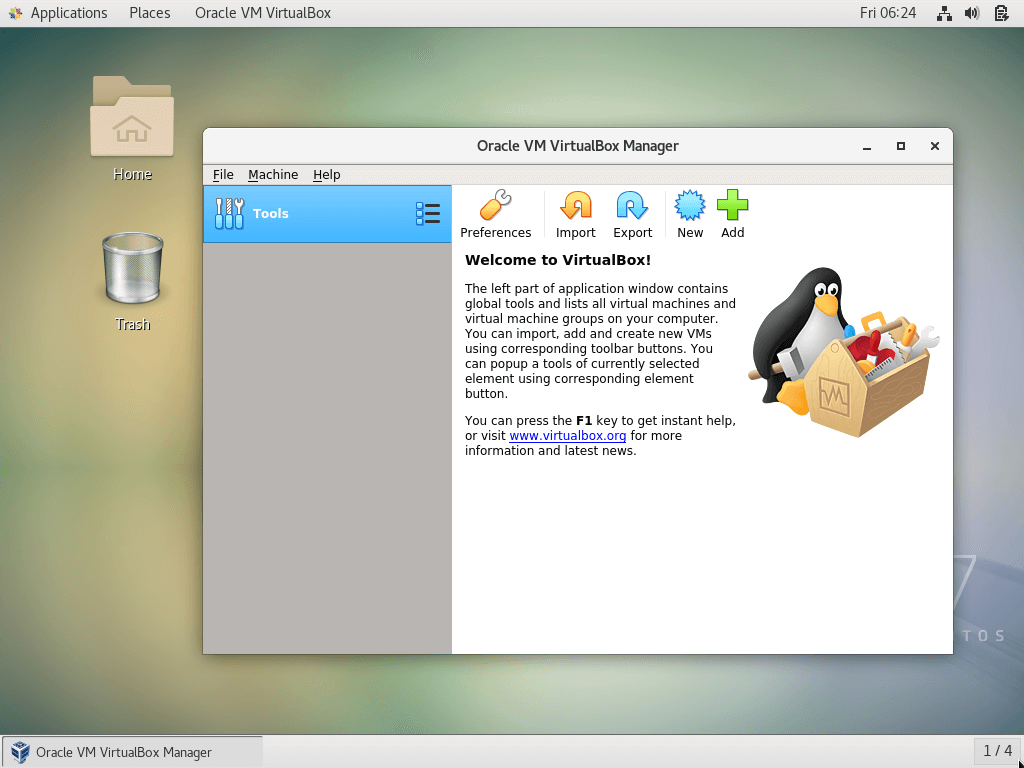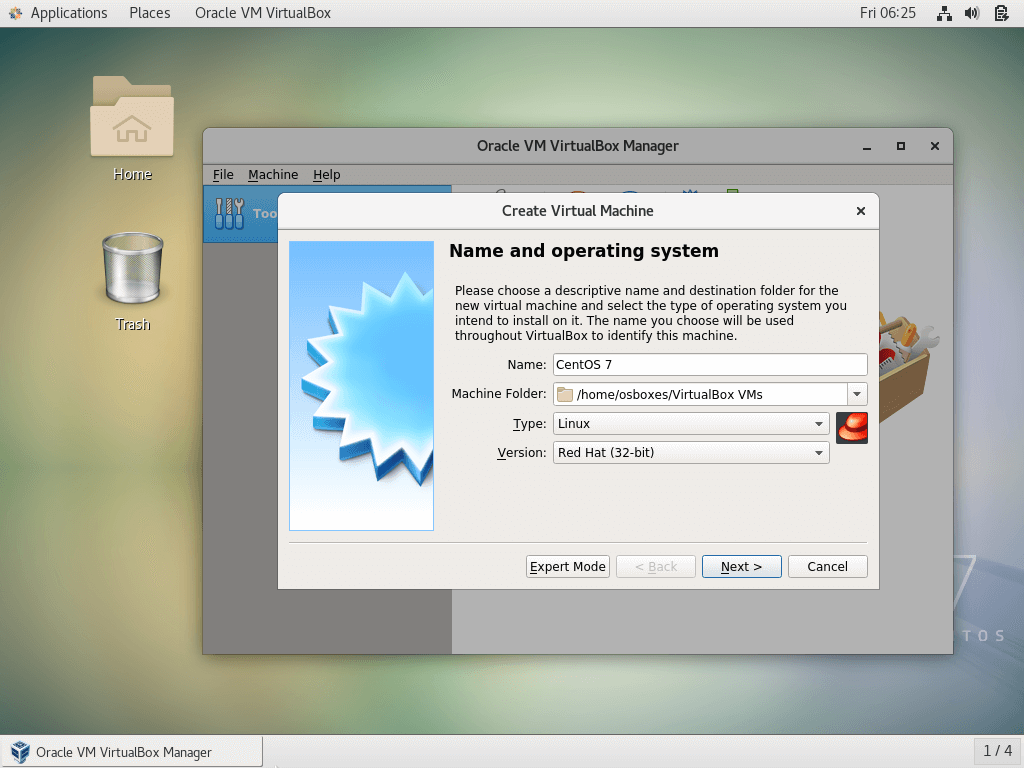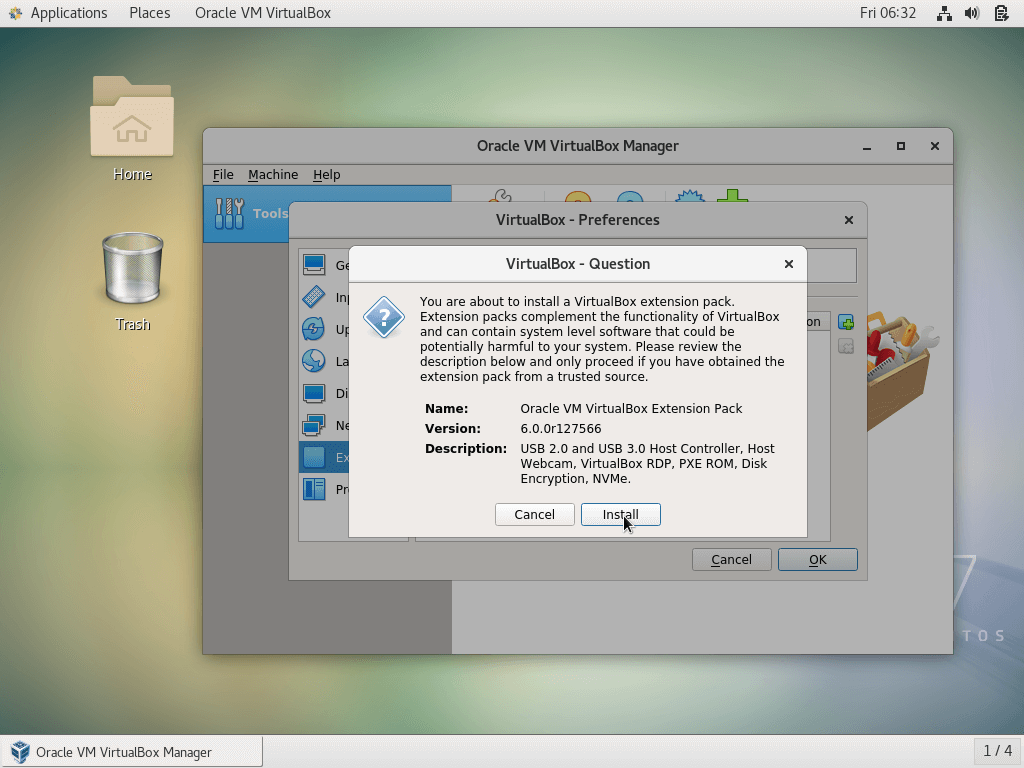How To Install Windows 7 Virtual Machine On Ubuntu
VirtualBox is an open-source cross-platform virtualization software, it can be installed on whatsoever operating arrangement and enable you to install and run multiple guests operating systems on the same computer.
For example, if you install it on your Linux system, y'all tin run Windows XP operating system nether it as a Guest OS or run Linux OS on your Windows organization and and so on. This way, you can install and run as many every bit guest operating systems as y'all like, the but limit is disk infinite and memory.
Recently Oracle has released the latest stable version of Virtualbox 6.1, the newest version of Virtual box comes with and then many major changes and new features added to information technology.
Yous can run into the complete new changelog details about VirtualBox half-dozen.1 on their Official Changelog Page.
This guide explains how to install VirtualBox 6.1 on RHEL, CentOS, and Fedora systems using VirtualBox's own repository with YUM and DNF tools.
This guide also explains how to install VirtualBox 6.1 on Debian, Ubuntu and Linux Mint systems using VirtualBox'southward own repository with APT-GET or APT command.
Installing VirtualBox 6.1 in RHEL/CentOS and Fedora
To install the latest stable version of VirtualBox, you need to first download the virtualbox.repo configuration file using the following wget command and so import the public key using rpm control.
----------------- On CentOS and RHEL ----------------- # wget https://download.virtualbox.org/virtualbox/rpm/rhel/virtualbox.repo -P /etc/yum.repos.d/ # rpm --import https://www.virtualbox.org/download/oracle_vbox.asc ----------------- On Fedora ----------------- # wget http://download.virtualbox.org/virtualbox/rpm/fedora/virtualbox.repo -P /etc/yum.repos.d/ # rpm --import https://www.virtualbox.org/download/oracle_vbox.asc
Next, enable the EPEL repository to install build tools and dependencies on the system.
----------------- On CentOS/RHEL 8 ----------------- # dnf install https://dl.fedoraproject.org/pub/epel/epel-release-latest-8.noarch.rpm ----------------- On CentOS/RHEL vii ----------------- # yum install https://dl.fedoraproject.org/pub/epel/epel-release-latest-7.noarch.rpm ----------------- On CentOS/RHEL 6 ----------------- # yum install https://dl.fedoraproject.org/pub/epel/epel-release-latest-6.noarch.rpm
Install Dependency Packages for VirtualBox
VirtualBox uses vboxdrv kernel module to control and allocate physical memory for the execution of invitee operating systems. Without this module, you can still use the VirtualBox to create and configure virtual machines, but they will not work.
So, to make VirtualBox fully functional y'all will need to update your system first, and then install some additional modules like DKMS, kernel-headers, and kernel-devel and some dependency packages.
----------------- On CentOS/RHEL viii ----------------- # dnf update # dnf install binutils kernel-devel kernel-headers libgomp brand patch gcc glibc-headers glibc-devel dkms -y ----------------- On CentOS/RHEL 7/half-dozen ----------------- # yum update # yum install binutils kernel-devel kernel-headers libgomp make patch gcc glibc-headers glibc-devel dkms -y ----------------- On Fedora ----------------- # dnf update # dnf install @development-tools # dnf install kernel-devel kernel-headers dkms qt5-qtx11extras elfutils-libelf-devel zlib-devel
Install VirtualBox 6.i
In one case you've installed all the needed dependency packages, you tin can install the latest version of VirtualBox using the post-obit command.
# dnf install VirtualBox-6.1 OR # yum install VirtualBox-6.ane
At this bespeak, you are ready to outset using VirtualBox past running the post-obit control on the concluding.
# virtualbox
If you lot become the following fault during the Virtualbox installation, it ways there is a conflict between the two Kernel versions.
This organization is currently not fix to build kernel modules. Please install the Linux kernel "header" files matching the current kernel
To resolve the issue, kickoff, bank check your installed kernel and so update the Linux kernel by running the command:
# uname -r # dnf update kernel-* Or # yum update kernel-*
When the update complete, reboot your organization and select the latest kernel from the grub kicking menu, this entry usually the start entry as y'all can see.
# reboot
Once the arrangement is washed with booting, log in and in one case once again confirm that the kernel-devel version at present matches the version of the Linux kernel.
# rpm -q kernel-devel # uname -r
Then, re-kickoff the build set-up process and confirm that your VirtualBox installation was successful by running:
# /sbin/vboxconfig # systemctl status vboxdrv
Troubleshooting
If y'all get any error bulletin like KERN_DIR or if your kernel source directory not detected automatically by the build process, y'all can set it past using the following command. Make sure you alter the kernel version according to your system equally shown in red colour.
## RHEL / CentOS / Fedora ## KERN_DIR=/usr/src/kernels/4.19.0-1.el7.elrepo.x86_64 ## Export KERN_DIR ## export KERN_DIR
Installing VirtualBox vi.1 in Debian, Ubuntu and Linux Mint
To install the latest stable version of VirtualBox, you need to add together the official Virtualbox repository using the following command.
$ wget -q https://www.virtualbox.org/download/oracle_vbox_2016.asc -O- | sudo apt-key add together - $ wget -q https://www.virtualbox.org/download/oracle_vbox.asc -O- | sudo apt-primal add - $ sudo apt install software-properties-common $ sudo add-apt-repository "deb [arch=amd64] http://download.virtualbox.org/virtualbox/debian $(lsb_release -cs) contrib
Then, update the software bundle list and install the latest version of VirtualBox.
$ sudo apt-get install virtualbox-6.1
Simply execute the following control to commencement it from the final or use launcher from the menu to get-go.
# VirtualBox
VirtualBox six.1 Screenshots on CentOS 7


Installing VirtualBox Extension Pack in Linux
If you demand some boosted functionality such as VirtualBox RDP, PXE, ROM with E1000 support and USB 2.0 Host Controller back up, etc. You need to download and install the VirtualBox Extension Pack using post-obit wget command.
# wget https://download.virtualbox.org/virtualbox/6.1.10/Oracle_VM_VirtualBox_Extension_Pack-6.1.10.vbox-extpack
To install the extension pack, you lot must have Virtualbox half-dozen.i installed, once you downloaded vbox-extpack open with Virtualbox as shown below.
If it doesn't work out, so open Virtaulbox –> Preferences –> Extensions and browse for the vbox-extpack to install it.

Read Also: How to Enable USB in VirtualBox
Updating VirtualBox
If you want to update the VirtualBox with the latest version in the future, you can only run the post-obit command to update it.
On RHEL/CentOS/Fedora
# yum update VirtualBox-*
On Ubuntu/Linux Mint
# apt-go install VirtualBox-*
Remove VirtualBox
If in case you desire to remove VirtualBox completely, just utilize the following control to remove it completely from your system.
On RHEL/CentOS/Fedora
# cd /etc/yum.repos.d/ # rm -rf virtualbox.repo # yum remove VirtualBox-*
On Ubuntu/Linux Mint
# apt-become remove VirtualBox-*
You can also Download VirtualBox 6.i for other Linux, Windows, and Mac OS X platforms.
If You Capeesh What We Do Hither On TecMint, You Should Consider:
TecMint is the fastest growing and about trusted community site for any kind of Linux Manufactures, Guides and Books on the web. Millions of people visit TecMint! to search or browse the thousands of published articles available FREELY to all.
If you like what you are reading, please consider buying us a coffee ( or 2 ) equally a token of appreciation.

We are thankful for your never ending support.
Source: https://www.tecmint.com/install-virtualbox-on-redhat-centos-fedora/
Posted by: moorehichat.blogspot.com


0 Response to "How To Install Windows 7 Virtual Machine On Ubuntu"
Post a Comment